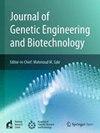利用免疫信息学设计与多种HLA等位基因相互作用的抗耳念珠菌多价表位疫苗
IF 2.8
Q3 Biochemistry, Genetics and Molecular Biology
Journal of Genetic Engineering and Biotechnology
Pub Date : 2025-03-01
DOI:10.1016/j.jgeb.2025.100474
引用次数: 0
摘要
对几种抗真菌药物的多药耐药的出现和替代治疗的缺乏限制了治疗选择,导致耳念珠菌感染的传播,特别是在免疫功能低下的患者中。由于auris缺乏有效的治疗方法,本工作旨在利用免疫信息学方法构建多表位疫苗。很少有计算机研究设计针对耳球菌的疫苗,主要针对特定蛋白,而不考虑非结构蛋白的重要性。整个蛋白质组的目标是鉴定抗原蛋白,因为非结构蛋白以外的成分也可能作为免疫原。抗原决定因子在靶蛋白中定位,并通过IEDB分析和预测工具进行筛选。不同的HLA类型在不同的种族中表现出不同的基因型频率。因此,为了设计一种有效的疫苗结构,候选t细胞抗原决定因子被用于人群覆盖。使用各种生物信息学工具和服务器对疫苗结构进行三维分析,包括预测、改进和验证。通过对接研究,计算验证了该疫苗与TLR4、TLR5、HLA-A*11:01和HLA-A*02:01的分子相互作用。对接的配合物进行了分子动力学(MD)模拟,以证实其稳定性、紧凑性和柔韧性。模拟研究表明,疫苗与免疫受体和MHC受体复合物在模拟时间内是稳定的。目前的研究结果表明,设计的疫苗可能是一种潜在的候选疫苗,并引发对金黄色葡萄球菌的免疫反应。然而,需要实验验证(体外/体内)来确认所设计的疫苗结构的有效性和安全性。本文章由计算机程序翻译,如有差异,请以英文原文为准。

Designing of multi-valent epitope vaccine displaying interactions with diverse HLA alleles against Candida auris using immuno-informatics
The emergence of multidrug resistance against several antifungal drugs and the absence of alternate therapy limits the treatment choices leading to the spread of Candida auris infections, especially in immunocompromised patients. This work aims to construct the multi-epitope vaccine using an immuno-informatics approach due to the lack of efficient treatments for C. auris. Very few in-silico studies have been conducted to design a vaccine against C. auris majorly targeting the specific proteins regardless of the importance of non-structural proteins. The whole proteome was targeted to identify the antigenic proteins because components other than non-structural proteins can also potentially act as immunogens. The antigenic determinants were mapped in the target proteins and screened via IEDB analysis and prediction tools. Distinctive HLA types manifested at varied genotypic frequencies in diverse ethnicities. Therefore, to design an effectual vaccine construct, the candidate T-cell antigenic determinants were employed for population coverage. Various bioinformatics tools and servers were used for the 3D analysis of vaccine structure, including prediction, refinement, and validation. The computational validation of the molecular interaction of the proposed vaccine with TLR4, TLR5, HLA-A*11:01, and HLA-A*02:01 was done using docking studies. The docked complexes were subjected to molecular dynamics (MD) simulations to confirm their stability, compactness, and flexibility. Simulation studies demonstrated that the vaccine complexed with immune and MHC receptors was stable during the simulation time. The outcome of the current study suggests the designed vaccine can be a potential vaccine candidate and elicit the immune response against C. auris. However, experimental verification (in-vitro/in-vivo) is required to confirm the effectiveness and safety of the designed vaccine construct.
求助全文
通过发布文献求助,成功后即可免费获取论文全文。
去求助
来源期刊

Journal of Genetic Engineering and Biotechnology
Biochemistry, Genetics and Molecular Biology-Biotechnology
CiteScore
5.70
自引率
5.70%
发文量
159
审稿时长
16 weeks
期刊介绍:
Journal of genetic engineering and biotechnology is devoted to rapid publication of full-length research papers that leads to significant contribution in advancing knowledge in genetic engineering and biotechnology and provide novel perspectives in this research area. JGEB includes all major themes related to genetic engineering and recombinant DNA. The area of interest of JGEB includes but not restricted to: •Plant genetics •Animal genetics •Bacterial enzymes •Agricultural Biotechnology, •Biochemistry, •Biophysics, •Bioinformatics, •Environmental Biotechnology, •Industrial Biotechnology, •Microbial biotechnology, •Medical Biotechnology, •Bioenergy, Biosafety, •Biosecurity, •Bioethics, •GMOS, •Genomic, •Proteomic JGEB accepts
 求助内容:
求助内容: 应助结果提醒方式:
应助结果提醒方式:


